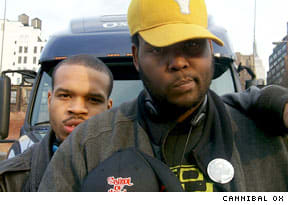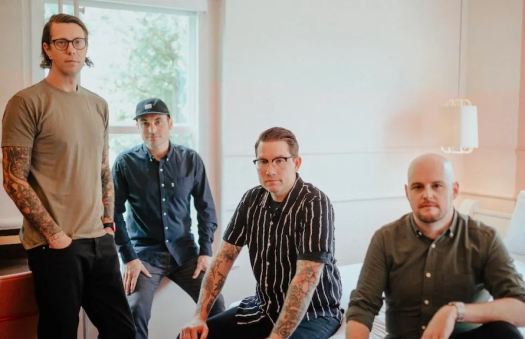Mike Ladd has seen the future - and the future is now. The slam poet turned English professor turned experimental MC is calling from the birthplace of hip-hop, the Bronx, and he's talking about the death of the form as we've known it. "The top-selling black artists in 2002 were white," he deadpans. "Justin Timberlake and Eminem."
White entertainers imitating black innovators is nothing new. But the phenomenon's current incarnation is unlike any of its precedents. To put it simply, Slim Shady is no Vanilla Ice. Indeed, Em and Timberlake are white artists who've got skills to match any of their black contemporaries. The days of white boys straining to act black are over. There's no strain anymore; it comes naturally.
White appropriation of black musical forms is as American as apple pie, whether it's jazz, blues or hip-hop. But while the usurpation of black forms has traditionally caused blacks to abandon said forms, USC cultural studies professor Todd Boyd argues that hip-hop is a special case. In his book, The New Head Nigga In Charge, Boyd writes that, "unlike the blues that formed the basis for rock and roll, hip-hop did not need to be repackaged in whiteface for it to be consumed by the masses."
Because whites embraced hip-hop in an undiluted form, argues Boyd, blacks need not abandon the genre. As industry mogul Russell Simmons writes in Life and Def, "We don't change for you; you adapt to us."
Still, African-American music is not inexorably tethered to its current incarnation. Eventually, it will develop in new ways. Rap's own ascendance was a reaction against the excesses of '70s funk. Black Americans had grown weary of funk's fantastic touches (sci-fi themes, fanciful costumes) and embraced hip-hop's depiction of inner city reality. The form's sociopolitical high point came in the early '90s with gangsta rap's lurid fatalism met the conscious movement's mordant social critiques.
Now, gangsta rappers are either movie stars or they're dead. Consciousness, meanwhile, stalled in the mid-'90s, passed on the right by Puffy's floss parade and on the left by the fluid abstractions of nihilists like Cannibal Ox.
The latter group seems to offer some hope for a return to keen social commentary. But there's no escaping the fact that the Brooklyn duo's fan base is largely white. Truth be told, black kids don't seem to have latched on to the underground's new wave. As former Digable Planets' MC Ishmael Butler says, "most underground rap is Caucasian."
According to Slug, the overlord of Minnesota's underground, black youths' disavowal of leftfield rap has everything to do with skin colour. "At a Ja Rule show," notes the MC, "you're going to see more black kids because he's black. It's easier to identify with somebody who looks like you. What can Aesop Rock say that will appeal to some black kid?"
While the underground has been overtaken by Caucasians, African-Americans look for their fix from mainstream acts like Nelly. But for all of the St. Lunatic's party appeal, he remains, essentially, a candy rapper, a man whose tunes are at once delicious and devoid of nutritional content. The market's current obsession with all things disposable runs counter to an essential truth: humans cannot live by candy alone.
Canada's own white rap icon, Buck 65, thinks that corporate rap's days are numbered. "What percentage of society can relate to these tales of these millionaires living in excess?" he asks. "How long can it last before people wake up and say, 'This isn't speaking to me anymore'?"
But despite its noble intentions, leftfield hip-hop might in fact be doing more harm than good in its efforts to keep it real. Butler, who's black, is frustrated by the underground's tendency to posture about what's worthy, and what's not. "I went to see these cats called Ugly Duckling, and they said: 'We take it back to when Michael Jackson was black.' And these were white dudes, right? How did it get to the point where these guys think they can say something like that?"
The market provides some insight. 70 percent of America's rap buying public is Caucasian. Whether it's teenagers dressing in Roc-A-Wear or drive-by Lotharios pumping Jay-Z down the block, many whites build their identity around hip-hop. Consequently, they take ownership of the form. As avant-gardist Ladd points out: "Now, white people are better at picking out the sell-outs than black people are."
Where does this appropriation leave blacks? How will the next generation of African-Americans express themselves? Will they continue to pursue a likely fruitless quest for financial control via corporate rap? Or will they cede hip-hop to the rest of the world and find their voice in a new, as-yet-undefined form?
Butler sees hip-hop's potential decline as a quintessentially American phenomenon. "You can complain and say it's not right," he allows, "but that's what America's all about. America eats stuff alive. We spread it out really thin and then move on to the next. Is it good? No. Is it bad? No. It's real."
White entertainers imitating black innovators is nothing new. But the phenomenon's current incarnation is unlike any of its precedents. To put it simply, Slim Shady is no Vanilla Ice. Indeed, Em and Timberlake are white artists who've got skills to match any of their black contemporaries. The days of white boys straining to act black are over. There's no strain anymore; it comes naturally.
White appropriation of black musical forms is as American as apple pie, whether it's jazz, blues or hip-hop. But while the usurpation of black forms has traditionally caused blacks to abandon said forms, USC cultural studies professor Todd Boyd argues that hip-hop is a special case. In his book, The New Head Nigga In Charge, Boyd writes that, "unlike the blues that formed the basis for rock and roll, hip-hop did not need to be repackaged in whiteface for it to be consumed by the masses."
Because whites embraced hip-hop in an undiluted form, argues Boyd, blacks need not abandon the genre. As industry mogul Russell Simmons writes in Life and Def, "We don't change for you; you adapt to us."
Still, African-American music is not inexorably tethered to its current incarnation. Eventually, it will develop in new ways. Rap's own ascendance was a reaction against the excesses of '70s funk. Black Americans had grown weary of funk's fantastic touches (sci-fi themes, fanciful costumes) and embraced hip-hop's depiction of inner city reality. The form's sociopolitical high point came in the early '90s with gangsta rap's lurid fatalism met the conscious movement's mordant social critiques.
Now, gangsta rappers are either movie stars or they're dead. Consciousness, meanwhile, stalled in the mid-'90s, passed on the right by Puffy's floss parade and on the left by the fluid abstractions of nihilists like Cannibal Ox.
The latter group seems to offer some hope for a return to keen social commentary. But there's no escaping the fact that the Brooklyn duo's fan base is largely white. Truth be told, black kids don't seem to have latched on to the underground's new wave. As former Digable Planets' MC Ishmael Butler says, "most underground rap is Caucasian."
According to Slug, the overlord of Minnesota's underground, black youths' disavowal of leftfield rap has everything to do with skin colour. "At a Ja Rule show," notes the MC, "you're going to see more black kids because he's black. It's easier to identify with somebody who looks like you. What can Aesop Rock say that will appeal to some black kid?"
While the underground has been overtaken by Caucasians, African-Americans look for their fix from mainstream acts like Nelly. But for all of the St. Lunatic's party appeal, he remains, essentially, a candy rapper, a man whose tunes are at once delicious and devoid of nutritional content. The market's current obsession with all things disposable runs counter to an essential truth: humans cannot live by candy alone.
Canada's own white rap icon, Buck 65, thinks that corporate rap's days are numbered. "What percentage of society can relate to these tales of these millionaires living in excess?" he asks. "How long can it last before people wake up and say, 'This isn't speaking to me anymore'?"
But despite its noble intentions, leftfield hip-hop might in fact be doing more harm than good in its efforts to keep it real. Butler, who's black, is frustrated by the underground's tendency to posture about what's worthy, and what's not. "I went to see these cats called Ugly Duckling, and they said: 'We take it back to when Michael Jackson was black.' And these were white dudes, right? How did it get to the point where these guys think they can say something like that?"
The market provides some insight. 70 percent of America's rap buying public is Caucasian. Whether it's teenagers dressing in Roc-A-Wear or drive-by Lotharios pumping Jay-Z down the block, many whites build their identity around hip-hop. Consequently, they take ownership of the form. As avant-gardist Ladd points out: "Now, white people are better at picking out the sell-outs than black people are."
Where does this appropriation leave blacks? How will the next generation of African-Americans express themselves? Will they continue to pursue a likely fruitless quest for financial control via corporate rap? Or will they cede hip-hop to the rest of the world and find their voice in a new, as-yet-undefined form?
Butler sees hip-hop's potential decline as a quintessentially American phenomenon. "You can complain and say it's not right," he allows, "but that's what America's all about. America eats stuff alive. We spread it out really thin and then move on to the next. Is it good? No. Is it bad? No. It's real."




